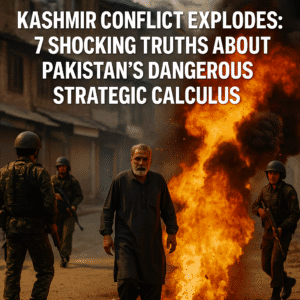Kashmir Conflict Explodes: 7 Shocking Truths About Pakistan’s Dangerous Strategic Calculus
The Kashmir conflict remains a volatile flashpoint, driven by Pakistan’s military reliance on tension with India to justify its political dominance and budget supremacy. Portraying Kashmir as Pakistan’s “jugular vein,” the army fuels proxy warfare through militant groups, exploiting nuclear deterrence to avoid full-scale retaliation. India, trapped between counterinsurgency crackdowns and symbolic strikes, faces eroded global credibility and domestic pressure.
The international community’s appeasement—avoiding sanctions, tolerating terror havens, and enabling IMF bailouts—emboldens Pakistan’s brinkmanship. Meanwhile, Kashmiris endure repression, radicalization, and economic ruin, reduced to pawns in a territorial feud. With Pakistan’s internal crises escalating and India’s nationalist rhetoric hardening, cyclical violence is inevitable. Absent accountability for militarism or meaningful dialogue, the region inches closer to a catastrophic miscalculation, leaving peace hostage to institutional self-interest.

Kashmir Conflict Explodes: 7 Shocking Truths About Pakistan’s Dangerous Strategic Calculus
The Kashmir conflict, a festering wound in South Asia, is poised to erupt again. Behind this inevitability lies a grim reality: Pakistan’s military establishment depends on perpetual tension with India to sustain its dominance. While the human cost mounts in Kashmir, the cycle of provocation and retaliation persists, fueled by institutional survival strategies, historical grievances, and geopolitical inertia.
The Military’s Existential Imperative
Pakistan’s army operates as a state within a state, consuming nearly 20% of the national budget while civilian infrastructure crumbles. Its legitimacy hinges on portraying India as an existential threat. Kashmir—the “unfinished business” of Partition—serves as the linchpin of this narrative. Without the Kashmir conflict, the military’s oversized role in politics and economy would face scrutiny, risking its grip on power.
This dynamic creates a perverse incentive: Escalation is not a bug but a feature. By deploying proxy groups like Lashkar-e-Taiba or Jaish-e-Mohammad, the army maintains plausible deniability while ensuring India remains locked in a costly counterinsurgency. Each attack, whether in Pulwama (2019) or Pahalgam (2025), reinforces Pakistan’s insurgent-style strategy—proving it can bleed India without triggering full-scale war.
Nuclear Blackmail and Asymmetric Warfare
Pakistan’s nuclear arsenal has emboldened its asymmetric tactics. Since testing nukes in 1998, it has pursued a “low-cost, high-impact” doctrine: Use proxies to destabilize Kashmir, counting on nuclear deterrence to limit India’s responses. The Kargil War (1999) and Mumbai attacks (2008) exemplify this approach. Even when India retaliates—as with cross-border strikes in 2016 and 2019—Pakistan’s infrastructure of militancy remains intact.
For India, this creates a lose-lose scenario. Heavy-handed crackdowns in Kashmir alienate civilians, validating Pakistan’s narrative of Indian oppression. Yet restraint risks appearing weak domestically. Prime Minister Modi’s “Operation Sindoor” (2025) reflects this trap: Symbolic strikes boost nationalist credentials but fail to dismantle terror networks.
The International Community’s Failed Calculus
Global powers have long treated Pakistan with kid gloves. Despite harboring UN-designated terrorists, Pakistan escaped Financial Action Task Force (FATF) blacklisting, shielded by its nuclear status and fears of state collapse. IMF bailouts and U.S. military aid (justified during the Afghan War) further insulated its army from accountability.
This appeasement has consequences. By refusing to impose meaningful costs—like cutting military aid or sanctioning intelligence officials—the international community enables Pakistan’s brinkmanship. Meanwhile, China’s geopolitical rivalry with India ensures Islamabad retains a powerful patron, diluting pressure.
Kashmiris: Pawns in a Proxy War
Amid the machinations, Kashmir’s civilians endure relentless suffering. India’s counterinsurgency measures—curfews, internet blackouts, and mass arrests—fuel resentment. Pakistan’s proxies exploit this discontent, recruiting disillusioned youth. Yet neither side offers a political vision for Kashmiris; both reduce the region to a territorial trophy.
The human toll is staggering: Disappearances, psychological trauma, and economic paralysis define daily life. Until Kashmiris are central to any resolution—whether autonomy, partition, or independence—the cycle will persist.
Breaking the Cycle: Pathways to De-escalation
- Targeted Sanctions on Military Elites: Rather than punishing Pakistan’s populace, the West could freeze assets of generals linked to proxy groups. This would directly challenge the army’s impunity.
- Diplomatic Parity: India must address Kashmir’s political aspirations. Restoring Article 370 (revoked in 2019) could rebuild trust, though Modi’s government shows little appetite for conciliation.
- Regional Dialogue: China, as a stakeholder in Pakistan and a rival to India, could mediate—but only if incentivized by broader trade or security concessions.
- Civil Society Engagement: Cross-border initiatives involving journalists, academics, and activists could humanize the conflict, eroding decades of dehumanizing propaganda.
The Inevitable Next Crisis
History suggests another flashpoint is imminent. Pakistan’s military, facing internal dissent over economic collapse and political unrest, may soon seek diversion through Kashmir. India, amid rising Hindu nationalism, will likely respond aggressively.
The world’s reluctance to intervene decisively ensures this stalemate will continue—until a miscalculation triggers a war neither side can control. Nuclear weapons may prevent annihilation, but they cannot shield millions from the fallout of a humanitarian catastrophe.
For Kashmir, peace remains a distant dream. For Pakistan and India, the conflict is a tragic theater where institutional survival trumps human security. Until that calculus changes, the drumbeat of war will only grow louder.
Insight for the Future:
The Kashmir conflict is not merely territorial; it’s a mirror reflecting the pathologies of two states. Pakistan’s identity crisis and India’s majoritarian turn fuel a rivalry with global repercussions. Solving Kashmir requires reimagining South Asia’s security architecture—one where armies serve nations, not the other way around. Until then, the region remains a tinderbox, waiting for a spark.
You must be logged in to post a comment.